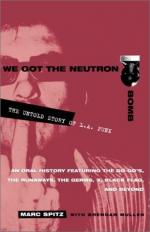|
This section contains 345 words (approx. 2 pages at 300 words per page) |
All nuclear weapons are surrounded by controversy. Both fission and fusion bombs release such enormous amounts of energy that they are always accompanied by the massive destruction of property and human life.
The neutron bomb, also called the enhanced radiation warhead, is a small fusion bomb that can be delivered by means of conventional cannons or howitzers or in small aircraft.
The bomb is characterized by the fact that its heat and blast effects are limited to a relatively small area. These effects normally extend no more than about 327 yds (300 m) from the point of detonation.
In contrast, the bomb releases massive amounts of gamma and neutron radiation. This radiation is able to penetrate most ordinary protective shields, such as armor, concrete, and earth. Both gamma and neutron radiation are very destructive to living tissue. They cause painful wounds that usually cause death over a period of days.
The overall effect of a neutron bomb is that it would kill humans within its area of effectiveness without causing damage to those at greater distances. Theoretically it could be used, therefore, for destroying an attacking enemy force without endangering friendly forces or civilian populations somewhat further away. Furthermore, the bomb would cause relatively modest damage to physical structures, such as buildings, while killing people in and around those structures.
In the late 1940s American physicist Samuel Cohen (1921-), a former participant in the Manhattan Project, first made the calculations necessary to create a neutron bomb. In the 1950s scientists at the University of California's Lawrence Livermore Laboratory developed the enhanced radiation warhead concept. Since that time, it has had a checkered development history. Research went forward aggressively in the 1970s when the first underground tests were conducted. Public outcry against such a weapon was great. Production was halted in the late 1970s and then resumed a few years later. According to Cohen, a useable neutron bomb has never materialized, and with the end of the Cold War, the potential place of a such a weapon in the United States arsenal is unclear.
|
This section contains 345 words (approx. 2 pages at 300 words per page) |


